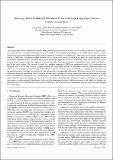Detecting stable distributed patterns of brain activation using Gini contrast
Author(s)
Langs, Georg; Menze, Bjoern H.; Lashkari, Danial; Golland, Polina
DownloadGolland_Detecting stable.pdf (11.12Mb)
PUBLISHER_CC
Publisher with Creative Commons License
Creative Commons Attribution
Terms of use
Metadata
Show full item recordAbstract
The relationship between spatially distributed fMRI patterns and experimental stimuli or tasks offers insights into cognitive processes beyond those traceable from individual local activations. The multivariate properties of the fMRI signals allow us to infer interactions among individual regions and to detect distributed activations of multiple areas. Detection of task-specific multivariate activity in fMRI data is an important open problem that has drawn much interest recently. In this paper, we study and demonstrate the benefits of random forest classifiers and the associated Gini importance measure for selecting voxel subsets that form a multivariate neural response. The Gini importance measure quantifies the predictive power of a particular feature when considered as part of the entire pattern. The measure is based on a random sampling of fMRI time points and voxels. As a consequence the resulting voxel score, or Gini contrast, is highly reproducible and reliably includes all informative features. The method does not rely on a priori assumptions about the signal distribution, a specific statistical or functional model or regularization. Instead, it uses the predictive power of features to characterize their relevance for encoding task information. The Gini contrast offers an additional advantage of directly quantifying the task-relevant information in a multiclass setting, rather than reducing the problem to several binary classification subproblems. In a multicategory visual fMRI study, the proposed method identified informative regions not detected by the univariate criteria, such as the t-test or the F-test. Including these additional regions in the feature set improves the accuracy of multicategory classification. Moreover, we demonstrate higher classification accuracy and stability of the detected spatial patterns across runs than the traditional methods such as the recursive feature elimination used in conjunction with support vector machines.
Date issued
2010-08Department
Massachusetts Institute of Technology. Computer Science and Artificial Intelligence Laboratory; Massachusetts Institute of Technology. Department of Electrical Engineering and Computer ScienceJournal
NeuroImage
Publisher
Elsevier
Citation
Langs, Georg, Bjoern H. Menze, Danial Lashkari, and Polina Golland. “Detecting Stable Distributed Patterns of Brain Activation Using Gini Contrast.” NeuroImage 56, no. 2 (May 2011): 497–507.
Version: Author's final manuscript
ISSN
10538119
1095-9572